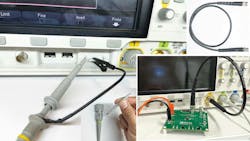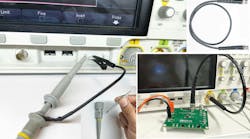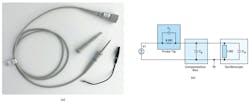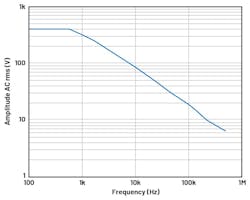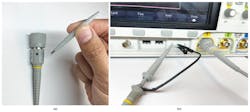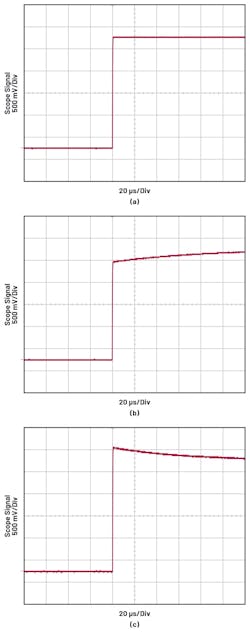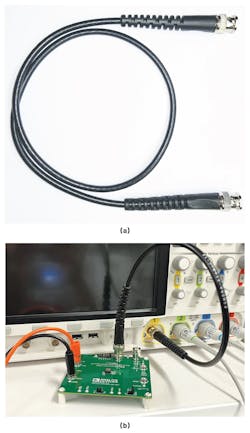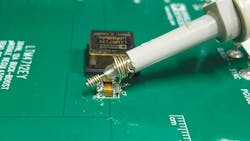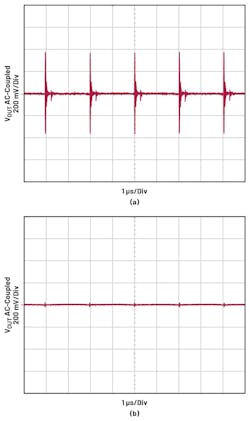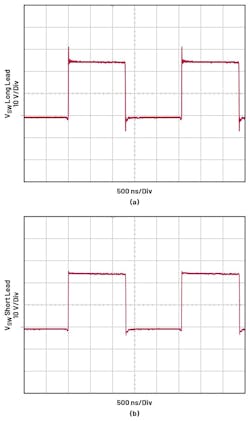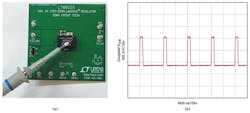SMPS Evaluation (Part 1): Measuring Voltage Ripple and Switching Nodes
What you’ll learn:
- How to select passive probes for various SMPS-related measurement tasks.
- Tips for measuring SMPS output-voltage ripple.
- How to measure switch-node waveforms in SMPSs.
When evaluating a switch-mode power supply (SMPS), there are many key parameters to assess and many factors to consider when observing a particular measurement. Making these measurements accurately is necessary to ensure design decisions aren’t led astray by faulty data.
Oscilloscope Probe Selection for Accurate SMPS Measurements
An oscilloscope is a powerful tool that engineers use to evaluate the performance of SMPS. However, it can’t be overstated how important proper measurement technique is to oscilloscope capture accuracy. The first step is selecting the right oscilloscope probe for the measurement being taken.
The versatile passive probe, which contains no active circuitry and thus needs no external power, is useful for accurate signal measurements. While one may take less disruptive measurements from extremely sensitive circuits with active probes, they’re also more complex and expensive. This section will explore oscilloscope measurements using passive 10× probes, passive 1× probes, and coaxial cables, with a brief discussion on how to determine which of the three is appropriate for certain measurements.
>>Download the PDF of this article, and check out the TechXchange for similar articles and videos
Using 10× Probes for High Voltage and High Frequency Signals
The 10× probe is the standard general-purpose probe for most modern oscilloscopes. They’re designated 10× because they have a 10:1 attenuation ratio, which means the signal being measured is reduced by a factor of ten. The oscilloscope’s display adjusts for this attenuation to display the correct voltage measurement, but this should be verified by the user because oscilloscopes may vary.
The probe has a large internal impedance, which, along with the oscilloscope impedance, divides the voltage signal by 10 (Fig. 1). This high impedance reduces loading on the oscilloscope and enables the probe to measure high voltages typically in the hundreds of volts. The typical bandwidth for 10× probes reaches hundreds of megahertz. The Keysight N2873A 10× probe, for example, is rated for 400 V DC voltage and up to 500 MHz.1
Care must also be taken to check the voltage derating curve versus the frequency of the probe. A voltage derating curve shows the maximum voltage the probe can measure while the signal has a certain frequency. As frequency increases, the maximum voltage that the probe can pass will decrease. The curve in Figure 2 shows the voltage derating curve for the N2873A 10× probe.
To ensure measurement accuracy in the kilohertz frequency range, many 10× probes have a built-in adjustable compensation screw (Fig. 3a). This probe adjustment lets users match the probe capacitance with the oscilloscope’s input capacitance, Ct/(Cin + Cp) = 1 MΩ/9 MΩ. Once adjusted, the voltage measurement will have the correct frequency response, ensuring that fast edges are measured correctly without overshoot or undershoot distortion.
The probe should be calibrated each time it’s connected to a new oscilloscope input to account for slight differences in the analog front ends, even when switching between different channels of the same oscilloscope. To calibrate the probe, connect it to the oscilloscope’s on-board square-wave generator (Fig. 3b) and adjust the probe’s compensation screw until the observed voltage signal appears square with little to no overshoot or rounding (Fig. 4).
The 10× probes are especially suited for measuring switch-node voltage in SMPSs and can be used to measure VIN; VOUT; and high-frequency, signal-level waveforms. The 10× probe is recommended for these measurements because of its ability to pass higher frequencies and voltages.
Low-Voltage Measurement with 1× Probes
Another common passive probe is the 1× probe (Fig. 5). These probes have a 1:1 attenuation ratio and don’t attenuate the voltage signal. These probes have a much lower impedance compared to the 10× probe and don’t require user calibration. The oscilloscope doesn’t adjust its scale for the measurement, enabling the screen capture to have a finer resolution—typically down to 1 mV/div.
These probes have a voltage range in the tens of volts. The bandwidth for such probes is typically rated to the tens of megahertz. A Fluke PM9001 1× probe, for example, has an impedance of less than 1 kΩ, a maximum voltage of 30 V, and a bandwidth of 15 MHz.2
A 1× probe is recommended for low-voltage and low-frequency measurements. When measuring voltages in SMPSs, this probe is recommended for small-signal tests such as input or output voltage ripples if the frequency of these ripples is in the low megahertz.
Benefits of Coaxial Cables for High-Frequency Measurements
The 10× and 1× passive probes connect to the oscilloscope’s inputs via cables with coaxial construction. Coaxial cables have a center conductor that’s used to transmit a signal and an outer braided metal-mesh layer to shield the cable and the signal from electromagnetic interference (EMI).
The coaxial cable itself can also be used as a voltage probe with proper terminations (Fig. 6a). These cables typically have a 50-Ω characteristic impedance; therefore, the oscilloscope input impedance must be set to 50 Ω.
When the 50-Ω impedance setting is applied in the oscilloscope, the maximum voltage that the scope can support is then typically limited to 5 V to protect the oscilloscope’s input from excess load. Although coaxial-cable measurements are limited to a low voltage range, they pass a much higher bandwidth. A Pomona 2249-C-12 BNC-BNC cable has a bandwidth of 4 GHz, higher than that of many oscilloscope probes.3
Using coaxial cables for SMPS measurements requires that the printed circuit board (PCB) itself be equipped with the appropriate matching connector (Fig. 6b). This means that the board must be designed in advance to incorporate the connector or have enough space to insert one. Several styles of coaxial cables that vary by gauge and connector type are suitable for demo board measurements.
Many Analog Devices μModule demo boards utilize 10-mm-diameter BNC connectors. The female BNC-BNC is commonly used for oscilloscope measurements because of its sturdy, reliable construction and wide availability. These coaxial cables are typically used to measure VOUT ripple in a dynamic load circuit on the output of an SMPS.
Subminiature Version B (SMB) and Uf.l connectors are two types of connectors used especially for high-frequency measurements. These connector types are also good for PCBs where space is a critical concern because of their small footprint.
A Summary of Probe Selection for SMPS Evaluation
The three probe types addressed in this article target specific areas:
- The 10× probe is recommended for capturing high-voltage and some high-frequency measurements.
- The 1× probe is recommended for small-voltage and low-frequency measurements.
- Coaxial cables are useful for low-voltage and high-frequency measurements but require a connector at the test point on the PCB.
These differences are summarized in the table.
Measuring Voltage Ripple in Switch-Mode Power Supplies
Output voltage ripple is a primary specification for power supplies and is a major parameter used to compare different designs. When measuring a ripple that’s tens of millivolts or smaller, the location on the board and the method of measurement can significantly influence the results. Coaxial cables can be used to measure the input or output ripple if the voltage is less than 5 V, and if the proper connectors are available on the evaluation board. Otherwise, either a 10× probe or a 1× probe is a good option.
However, the standard ground clip of the 10× and 1× probes would form a long measurement loop that will reduce measurement accuracy by increasing the probe’s impedance. Pigtail leads are recommended to take this measurement and should make solid contact with the probe tip and ground ring (Fig. 7).
The difference between test results with a standard probe ground connection and pigtail leads can be seen in Figure 8. Standard bus wire can be used to construct pigtails by wrapping them into a tightly looped coil. Be sure to avoid creating the pigtail on the probe itself because this could damage the probe.
Output-voltage ripple is typically measured across the device’s output-voltage sensing point. In μModule demo boards, the optimized minimal ripple is captured on a ceramic capacitor mounted on the back side of the board directly beneath the SMPS output connector.
By measuring on a ceramic capacitor, the ripple from the capacitor’s equivalent series resistance (ESR) is less than when measured across a bulk capacitor. By measuring on the bottom of the board, opposite the converter, the board itself provides shielding from EMI noise.
In other applications, users may be interested in measuring output voltage ripple at a point far from the converter such as where a load is applied. The shape of the output voltage ripple will differ here from a point next to the converter because of parasitic effects from the PCB and the amount of capacitance at this measurement point.
Input voltage ripple should be measured across the input voltage capacitor closest to the IC, as this directly measures the input voltage seen by the IC. Oscilloscope probe pigtails should be used in this measurement for the same reasons described above.
Best Practices for Measuring Switch-Node Waveforms
Proper measurement of the switch node is critical because improper measurement techniques can yield incorrect waveforms, most commonly by introducing false ringing, which can derail debug efforts. To prevent this, use short pigtail leads to ground the oscilloscope probe.
Oftentimes, there will not be an easily accessible ground next to the switch node. If this is the case, scrape off a small patch of solder mask from the ground plane next to the switch node and install a pigtail on the newly exposed ground to use for the measurement. Take care not to short the switch node to ground during this process. Figure 9 shows the difference between switch-node waveforms with a standard probe ground connection and with pigtail leads.
In some μModule parts, the switch node is integrated into the part to reduce the solution’s area and isn’t directly accessible, such as for the LTM8050, a single-channel, 2-A step-down converter. For these parts, the switching-node waveform shape can still be viewed by placing a floating oscilloscope probe above the μModule package (Fig. 10a). This will take a coupled measurement of the waveform shape that can be used to view the switching frequency and check for cycle-to-cycle stability (Fig. 10b). This coupled waveform will not give an accurate voltage magnitude measurement.
The best probe for measuring the switch node is typically a 10× probe, as the signal is typically higher frequency or amplitude than a 1× probe will be able to measure.
SMPSs are the go-to power circuit for most applications requiring voltage increases or significant voltage decreases, and for good reason—they offer the optimal combination of noise performance, efficiency, and solution size for many situations. A plethora of decisions must be made when designing an SMPS circuit, and accurate measurements of key parameters are needed to inform these decisions and ensure you’re making the right choice.
References
1. Keysight N2873A 10× Oscilloscope Probe.
2. Fluke PM9001 1× Oscilloscope Probe.
3. Pomona Electronics BNC Cable.
“Switch Mode Power Supply Basics.” Analog Devices, Inc., September 2007.
Aldrick Limjoco. “Understanding Switching Regulator Output Artifacts Expedites Power Supply Design.” Analog Dialogue, Vol. 48, No. 8, August 2014.
Aldrick Limjoco. “Measuring Output Ripple and Switching Transients in Switching Regulators.” Analog Devices, Inc., January 2013.
>>Download the PDF of this article, and check out the TechXchange for similar articles and videos
About the Author
Wesley Ballar
Senior Product Applications Engineer, Analog Devices Inc.
Wesley Ballar is an applications engineer supporting µModule products in the Multimarket Applications group. He has supported the µModule team in various roles since joining Analog Devices in 2016. Wesley received a bachelor’s degree in electrical engineering from California Polytechnic State University in 2015.
Jake Ciolfi
Field Applications Engineer, Analog Devices Inc.
Jake Ciolfi is a field applications engineer in the Americas Northeast region, specializing in power and RF applications. He has been with Analog Devices since 2021 after receiving a bachelor’s degree in electrical and computer engineering from Worcester Polytechnic Institute in the same year.
